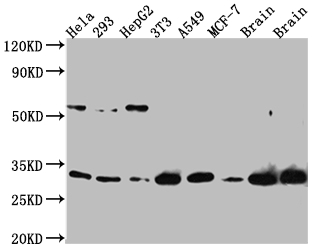To produce the PGAM1 recombinant antibody, four main steps are involved. First, the PGAM1 monoclonal antibody gene is sequenced, followed by the cloning of the gene into a plasmid vector. The recombinant vector is then introduced into a host cell line, and the PGAM1 recombinant monoclonal antibody is purified from the cell culture supernatant using affinity chromatography. Finally, the purified antibody is tested and characterized. The PGAM1 monoclonal antibody is derived from hybridomas that produce the PGAM1 antibody, with a synthesized peptide derived from human PGAM1 being used as the immunogen during generation. The resulting PGAM1 recombinant monoclonal antibody is highly recommended for ELISA and WB applications to detect PGAM1 protein from human, mouse, and rat species.
PGAM1 is an enzyme that plays a crucial role in the glycolysis pathway, which is the primary metabolic pathway that converts glucose into pyruvate to produce ATP (adenosine triphosphate) for cellular energy. Specifically, PGAM1 catalyzes the conversion of 3-phosphoglycerate (3-PG) to 2-phosphoglycerate (2-PG) in the second step of glycolysis. This reaction generates a molecule of ATP and a molecule of water, and it is reversible, allowing the enzyme to function in both the glycolysis and gluconeogenesis pathways. In addition to its role in energy metabolism, PGAM1 has also been implicated in the regulation of cell proliferation and cancer progression.






